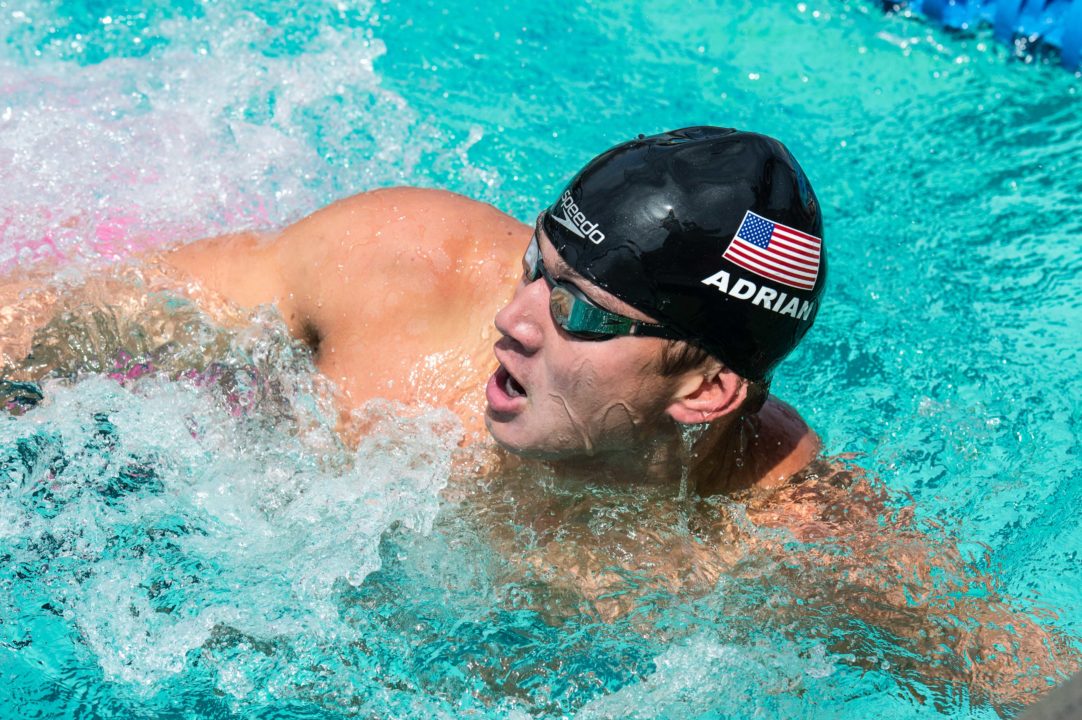U.S. Masters Swimming released a statement today saying that a timing system error led to Nathan Adrian’s American record-tying swim being incorrectly given a faster final time than he actually went. Adrian’s swim in the 100 freestyle was originally listed at a 41.08, but was in actuality a 41.13, according to USMS.
In a strange quirk at a very-fast Masters National meet, the error happened because the timing system at Nationals simply wasn’t prepared for Adrian’s speed – the full USMS statement is below:
Yesterday we reported that Nathan Adrian tied his own American record of 41.08 in the 100 freestyle at the 2014 Nationwide USMS Spring National Championship. We made a mistake and the official time is 41.13. The error was due to a series of procedural issues, and we’re working diligently to prevent it from reoccurring.The truth is, Mr. Adrian swam faster than our standard timing procedures were prepared for. The pad timing system is set with a 20-second delay so that after a start, when swimmers from the finishing heat are exiting the pool and bumping the timing pads, that incidental contact won’t trip the pads and result in an error for the heat in the water. Under normal circumstances, the 20 seconds allows for the finished heat to exit the water before the current heat returns to hit the pad again. However, Mr. Adrian swims his 50s faster than 20 seconds. We should have been prepared for this and set the delay to accommodate his speed on the first 50 of his 100.We offer our sincerest apologies to Mr. Adrian. We were honored to have him compete at the 2014 Spring Nationals and we hope our error will not prevent him from swimming at a Masters Swimming competition in the future.

Maybe it’s a California thing to mess with times. SoCal and now NorCal. Kind of scary that USA Swimming Nationals are in SoCal in a few months.
Honestly, who cares? If they had Adrian swimming under 41 seconds this would be a story, but the erroneous time just had him matching his existing record, so it’s sort of a non-story to me.
None of this makes sense.
1) Why did they have a 20 second delay in the pads, since there were no flyover starts? Even if there was a delay built in, the timing operator *should* have reset the system before the next heat.
2) Unless I’m missing something, that .05 difference should have only affected his split on the first 50, not his final time.
3) If it did affect his final time, it should have added .05 to everyone’s time in that heat, right?
“Only” a 41.13. Yawn.
If you are suspicious and you have the video, you might be able to time the swim yourself.
I timed it twice: got 41:06 and 41:08.
Ah, I had thought I heard the announcer say “41.13” in one the video of that swim that got posted somewhere. This explains that…kinda?
USMS is trying to cover their behinds. Everyone who was at the meet saw the clock register :41.13 when he touched. It then disappeared and changed to :41.08 and the crowd went crazy. The same thing happened the day before in the 50: the clock actually said :20-point Something and then it changed to an :18.9 and the. 18.7. This only happened with Adrian’s swims.
My guess: the meet folks wanted to put on a good show for the home crowd so they dipped into the backup clicker times searching for the fastest one. This unravelled on them when it was revealed after the fact that he had tied the American record. All the sudden things had to be… Read more »
No, they aren’t. The problem really was the timing system 20 second arming delay. The system automatically went to the backups (buttons) and that’s where the 41.08 came from. The timing operator then overruled this with the pad time of 41.13. The timing system ‘thought’ the 41.13 was his 50 split due to the 20 second lock out.
Makes sense now where the time came from.
So as far as the electronic timing was concerned Adrian did not finish the race. People were excited when they saw his “50” split of 41.08. They go to the plunger/hand times and he happens to get .05 slower.